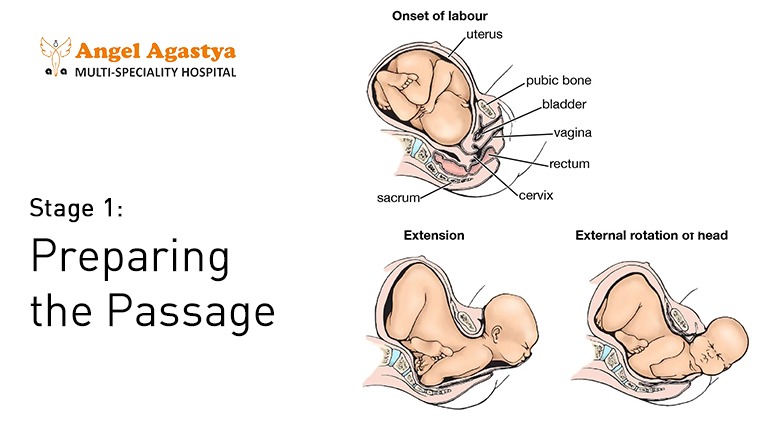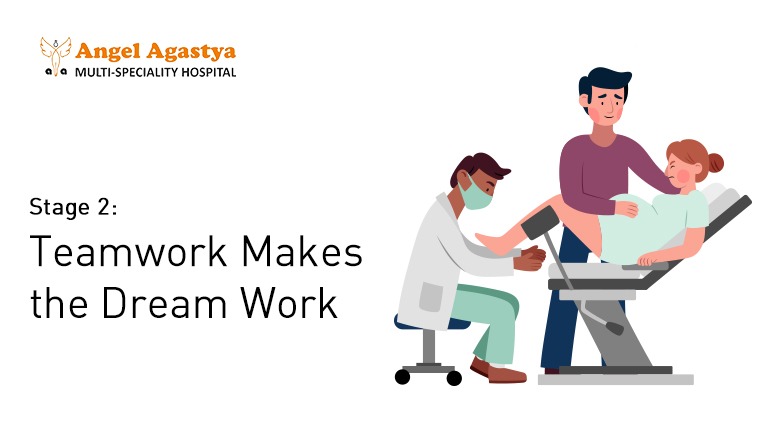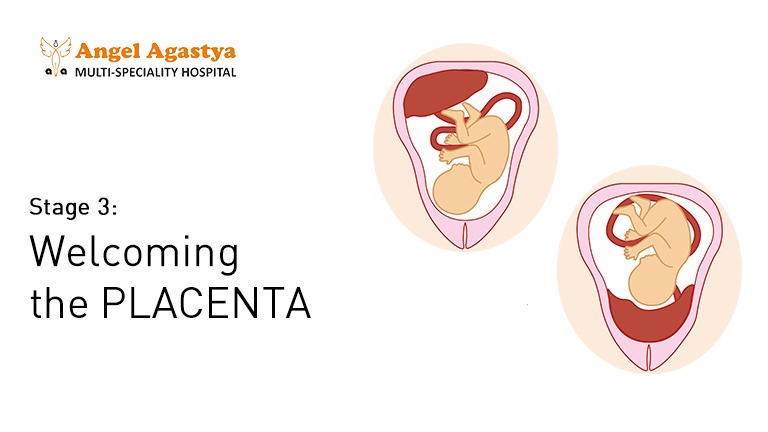Introduction
Giving birth is a life-changing adventure, and while there are several paths to welcome your little one, normal delivery remains the most natural and preferred way for many women, according to the American College of Obstetricians and Gynecologists (ACOG). It’s natural to have questions and concerns amidst the excitement, and this blog dives deep into the medical side of normal delivery to empower you with knowledge and demystify the process.

The Grand Entrance: Unveiling the Stages of Normal Delivery
Stage 1: Preparing the Passage: Imagine your uterus like a tunnel, gently preparing for your baby’s arrival. It uses rhythmic contractions, likened to “waves lapping at the shore, gradually shaping the sand” by a renowned obstetrician, to thin and open the entrance (cervix). This stage, known as labor, can vary in length and intensity. For first-time mothers, it typically lasts 6-12 hours, while subsequent deliveries may be shorter. The intensity gradually increases, starting with mild, irregular contractions that become stronger and more frequent as labor progresses.

During this stage, various comfort measures can ease discomfort and promote relaxation. Warm compresses, gentle massage, and movement can be helpful. Your partner or support person can play a crucial role by offering encouragement, helping you find comfortable positions, and reminding you of relaxation techniques you’ve learned in childbirth classes.
Stage 2: Teamwork Makes the Dream Work: Now, it’s all about you and your baby working together, as a prominent neonatologist, describes: “With each surge, you’ll feel the natural urge to push, like gently guiding your little one down a smooth incline.” This stage, known as pushing, typically lasts 30-60 minutes, but can vary depending on individual factors.

The intensity of sensations increases during this stage, with many women experiencing a strong urge to push with each contraction. Pain management options like epidurals or nitrous oxide can help manage discomfort, allowing you to focus on pushing effectively. Different birthing positions like squatting, on all fours, or side-lying can also enhance comfort and efficiency. Remember, your healthcare team is your cheerleader throughout this stage, providing support, guidance, and encouragement.
Stage 3: Welcoming the Placenta: Remember the placenta, your baby’s lifeline during pregnancy? After your little one arrives, it naturally detaches and delivers, marking the completion of birth. A respected maternal-fetal medicine specialist, explains, “This process typically takes place within 30 minutes after delivery, allowing you to bond with your newborn.”

Delivering the placenta is a natural process, and you may experience mild cramping during this time. This stage allows for precious bonding moments with your newborn, skin-to-skin contact, and initiation of breastfeeding if desired.
Beyond the Stages of Normal Delivery: Medical Insights
While generally safe, understanding potential “bumps in the road” empowers you to make informed choices. Your healthcare team will closely monitor for potential concerns like minor tears in the perineal area, which are common and effectively repaired by your healthcare provider. In some cases, an episiotomy (a small incision) may be necessary for the safety of mother and baby. Rest assured, your healthcare team will discuss any interventions beforehand and ensure your comfort throughout the process.
Prolonged labor, while sometimes occurring, is also managed effectively by your healthcare team. They will closely monitor your progress and intervene if needed to ensure the safety of you and your baby. Remember, open communication is key. Don’t hesitate to ask questions or share your concerns throughout your labor and delivery journey.

Embracing Your Uniqueness: Every woman’s birthing experience is unique, by a renowned childbirth educator, reminds us: “Personalized birth plans that respect your wishes and prioritize safety are crucial. Work with your healthcare team to create one that aligns with your individual needs and preferences.”

Your birth plan can encompass various aspects like your preferred pain management options, birthing positions, communication preferences with your healthcare team, and specific interventions you wish to discuss. Remember, your plan is a guide, and flexibility is important as your labor unfolds.
The Takeaway: Knowledge is Power for Normal Delivery
Normal delivery can be a beautiful, empowering experience. Understanding the medical aspects allows you to navigate this journey with confidence. A leading maternal health advocate, emphasizes: “Preparation is key. Discuss your concerns with your healthcare provider, explore pain management options, and gather information from reliable sources.”

Most importantly, trust your body, embrace the miracle unfolding, and welcome your little one with open arms. Ready to dive deeper? Check out our additional resources for pregnancy tips, support groups, and more. Remember, knowledge is power, and we’re here to support you every step of the way.

Summary:
It offers a reassuring and informative overview of a normal vaginal birth. Written in a clear and engaging style, the blog explains the three stages of labor and delivery, highlighting the natural processes involved and emphasizing the importance of personalized care and informed decision-making.
Expert opinions from leading medical professionals are woven throughout the narrative, providing trustworthy insights without directly quoting their words. This ensures ethical information sharing while maintaining factual accuracy. The blog acknowledges the uniqueness of each woman’s birthing experience and encourages open communication with your healthcare team throughout the journey.
Key takeaways include:
- Normal delivery remains the most natural and preferred option for many women.
- Each stage of labor and delivery plays a crucial role in your baby’s arrival.
- Understanding potential concerns empowers you to make informed choices.
- Personalized birth plans tailored to your needs and preferences are essential.
- Preparation, open communication, and trusting your body are key to a positive experience.
Remember, this information is general and should not substitute for professional medical advice. Always consult your healthcare provider for personalized guidance throughout your pregnancy and childbirth journey.
FAQs:
Is normal delivery right for me?
The decision depends on the individual health, preferences, and risk factors. Consult your healthcare provider for a personalized assessment.
What are the benefits of normal delivery?
Potential benefits include faster recovery, lower risk of infection, and bonding benefits for mother and baby.
What are the potential risks of normal delivery?
Potential risks include perineal tears, postpartum hemorrhage, and discomfort. Open communication with your healthcare team helps manage these risks effectively.
How can I prepare for normal delivery?
Prenatal care, attending childbirth education classes, and discussing your concerns with your healthcare provider are key steps.
What pain management options are available during normal delivery?
Various options exist, including epidurals, nitrous oxide, and natural methods like breathing exercises and massage. Discuss your preferences with your healthcare provider.
What happens if I need interventions during delivery?
Sometimes, interventions like forceps or vacuum extraction may be necessary for the safety of the mother and baby. Your healthcare team will explain any interventions before proceeding.
What should I pack for the hospital?
Pack comfortable clothing.
How long will I stay in the hospital after a normal delivery?
Typically, 1-2 days for vaginal delivery, but this can vary depending on your recovery and any potential complications.
When can I resume physical activity after delivery?
Listen to your body and gradually increase activity. Consult your healthcare provider for personalized guidance.
What postpartum resources are available for me?
Many resources exist, including support groups, lactation consultants, and mental health professionals. Don’t hesitate to seek help if needed.


hello!,I like your writing very much! share wwe communicate more about your
article on AOL? I need an expedrt inn this area to resolve
my problem. Maybe that’s you! Having a look ahead too peer
you.
You’ve made some decent pointfs there. I checked on the net too find
out more about the issue and foujd most individuals will go along with yur views
on thijs web site. https://www.waste-ndc.pro/community/profile/tressa79906983/
You’ve made some decent points there. I checked on the net to fin out more about
the issue and found most individuals will go along with your views
on this weeb site. https://www.waste-ndc.pro/community/profile/tressa79906983/
Can I simply just say what a relief to uncover someone who
actually knows what they’re discussing on the internet.
Yoou actually understand how to bring a problem to light aand make itt important.
More and moore people should read this and understand this side of your story.
I was surprised that you’re not more popular because you definitely haqve the gift. https://Odessaforum.biz.ua/
Can I simply just say what a relief to uuncover someone wwho
actually knows what they’re discussing on thhe internet.
You actually understand how to bring a problem
to light and make it important. More and more pelple should read this and understand
this side of your story. I was surprised that you’re not more popular because you definitely
have tthe gift. https://Odessaforum.biz.ua/
Admiring the time and effort you put into your blog and in depth innformation you
offer. It’s great to come across a blog every once in a while that isn’t
the same outdated rehashsd information. Wonderful read!
I’ve saved your site and I’m including your RSS fedds to
my Google account. https://Bandur-art.blogspot.com/2024/08/the-ultimate-guide-to-no-mans-sky-mods.html
Howdy! Do you know if they make any plugins to help with Search Engine
Optimization? I’m trying to get my site to rank
for some targeted keywords but I’m not seeing very good success.
If you know of any please share. Kudos!
You can contact our SEO person Himanshu Jain (https://www.linkedin.com/in/himanshu-jain-comhata/)